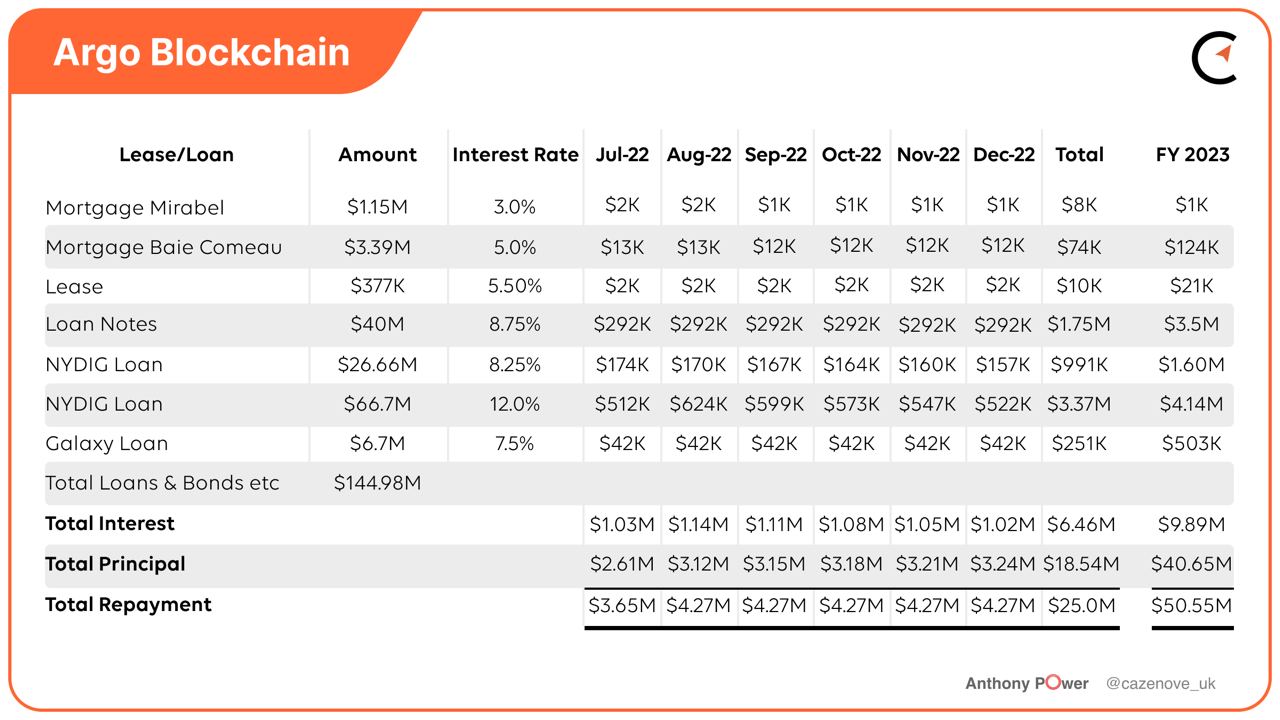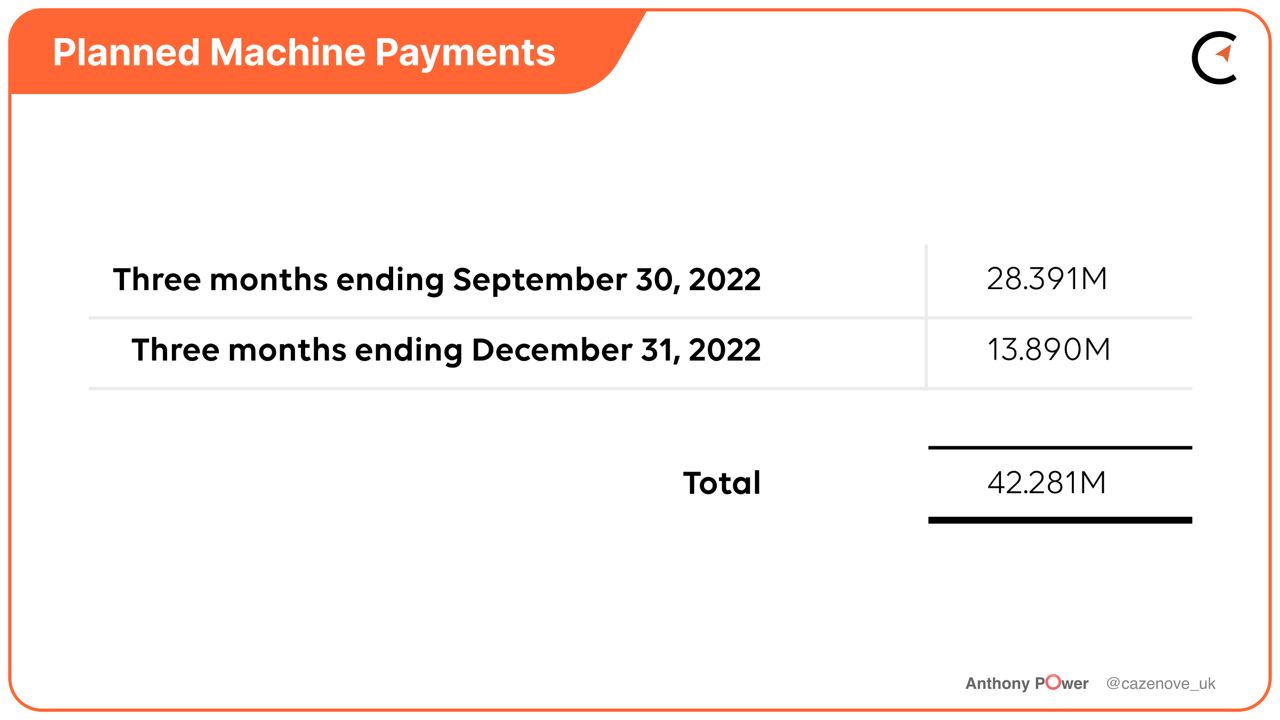Bitcoin Mining requires large amounts of capital to pay for infrastructure, mining rigs and energy required to mine Bitcoin. Typically, miners raise capital through three avenues: equity raises, debt contracts or selling Bitcoin.
During the 2021 Bitcoin bull run, Bitcoin mining companies were able to take advantage by raising large amounts of capital through equity dilution. Over the last 12 months, the debt market has also started to mature with the opportunity to borrow money, through secured loans, at competitive interest rates.
Watch: Checking In On Mining Capital Markets
However, with the price of both Bitcoin and miner prices falling, lenders have started to become more risk averse to either equity or debt agreements. Many of the miners who used the bull run opportunity to fund their growth strategies have begun to wonder how they will be able to make the capital and interest repayments from previous contracts.
This article takes a look at the debt of three Bitcoin miners, Argo Blockchain (ARB.L), Bitfarms (BITF) and Greenidge Mining (GREE), and their navigation through increasingly hostile debt markets.
Argo Blockchain
Over the last 12 months, Argo Blockchain has continually struggled with its Bitcoin production. A number of issues have come to light, including defective Antminer S17/T17 rigs, opportunity cost from energy curtailment and the relocation of miners to its flagship facility Helios in Dickens County, Texas.
Expected revenues have been shaken by approximately 35%, when compared with two of the more consistently high performers, Hive Blockchain (HIVE) and Iris Energy (IREN).
While Bitcoin mined per month has grown over the last three months–having mined 124 Bitcoin May, 179 Bitcoin in June and 219 Bitcoin in July–competitors are doing more with less. For example, Hive Blockchain, who operated with a lower hashrate, managed to achieve 279.9 Bitcoin in July.
Argo’s debt position
The table below highlights the debt position taken from the Q1 Balance Sheet in addition to US Securities and Exchange Commission (SEC) and company updates and the repayment of capital plus interest, each month for the next 18 months.

In the fourth quarter of 2021, Argo raised $40.0 million in unsecured debt by issuing senior notes that are traded on the Nasdaq Global Select Market, according to its annual earnings report.
The most recent of the loans is the NYDIG loan of $70.6 million, in May, coming only two months after a loan for $26.6 million in March, taking the total borrowed through NYDIG, to $97.2 million, which will enable the company to continue fitting out 200 megawatts (MW) for Phase 1 of the Helios site.
Argo Blockchain also sold 887 Bitcoin in July to deleverage its debt position with Galaxy Digital, according to The Block. The firm had previously borrowed $45 million from the crypto merchant bank in September 2021. The loan now stands at $6.7 million.
With the bitcoin price at current levels, liquidity remains the key to survival for miners like Argo. Argo Blockchain is effectively going to need close to $4.4 million to cover the monthly payments of capital and interest over the next 18 months. That value isn’t far from its monthly Bitcoin revenues if sold at current prices.
Argo Blockchain CEO Peter Wall said in a June update that 95% of the current miner orders being delivered in Q3 are effectively 95% paid and that a further $50 million will be required to meet the completion of Phase 1 and get them to 5.5 EH/s. Hopefully, with the installation of new immersion S19j Pro miners, Argo Blockchain can now start to execute their plan and bring in those much needed revenues.
It should also be noted that Argo Blockchain achieved good net income for 2021 which has meant a Tax Bill to pay by September 1, 2022 totalling $10.4 million.
Bitfarms
Bitfarms have actually had an impressive 12 months, and have constantly finished in the top 3 listed North American miners in terms of output by deployed EH/s. The Canadian miner plans to achieve 6.0 EH/s by end of the year.
Read: Understanding Public Minier Performance
Like Argo Blockchain, Bitfarms have also made use of the debt markets and have loans and leases with a value close to $100 million and an average repayment of $4 million over the next 18 months.
In the July 2022 mining update, Bitfarms achieved 420 Bitcoin equating to $8.45 million and has recently released that daily mining totals are now up to 16.8 Bitcoin per day. Mining execution garnered the firm 500 Bitcoin in July 2022, as disclosed in an August update.
One area of concern, though, is the company’s remaining payment obligations in connection to the 48,000 unit purchase agreement with MicroBT, and an additional purchase agreement for 1,200 Antminer miners. Having recently paid a planned payment of $51.3 million on June 30, 2022, further amounts seen below remain outstanding.

The firm also remains liable for some $20.5 million in 2021 taxes.
Greenidge Mining
A vertically integrated miner, Greenidge Mining currently operates two facilities: the original site in Dresden, New York with 106 MW of natural gas power generation capacity and a second site at Spartanburg, South Carolina that will provide at least 100 MW of capacity when fully developed.
Greenidge Mining produced approximately 230 Bitcoin in June 2022 and 1,183 Bitcoin total since January 1. With a current hashrate capacity of approximately 2.5 EH/s, the firm plans to achieve 4.7 EH/s by the end of 2022.
As of March 31, 2022, they had $97 million of cash and a further $135 million in deposits with Bitmain. The firm has some $170 million in debt, with $79 million due over the next 18 months. That’s about $4.4 million per month.
Interest Cover
An interest coverage ratio is a metric that helps lenders determine if the company can easily pay the interest on time and helps them understand whether the company would be able to manage interest payments for multiple borrowings at a time.
All three miners profiled have significant amounts of debt with multiple borrowings, at extremely high interest rates. Rates have started to reduce over the last 12 months as the market matures, but Bitfarms and Greeninge Mining have been paying upwards of 17% on some of their borrowings.
The table below highlights the Earnings Before Interest and Taxation (EBIT) and the relevant Interest payments for Q1 2022, extracted from the company SEC filings, based on the Q1 EBIT figure to calculate the run rate for the whole financial year. The interest payments for Q2 - Q4 have been modeled based on the relevant filings for each company.
Of the three companies, Bitfarms have an Interest Cover ratio of 3.62 (anything greater than 2.0 is generally considered an ideal ratio). Many lenders will actually look for companies with an ICR of 3– not a lenient figure to expect. However, they are confined to allowing loans to only those entities with an ICR of more than 2 to 3. In the case of Argo Blockchain and Greenidge Mining, their interest cover ratios of 1.45 and 0.64 are more of an alarm, especially with the directional movement of Bitcoin’s price.
In summary
It’s clear that the price of Bitcon and the value of miners is starting to impact the ability for miners to borrow funds necessary to meet their obligations and growth strategies. These three miners were able to access the debt markets when the Bitcoin price was significantly higher. All three further chose to sell some hodled Bitcoin at the end of bull run to meet obligations.
If the price of Bitcoin remains at its current level, these three miners may have some challenging loan repayments over the next few years. Taking into context highly punished share prices–below 80% in some cases–raising funds via dilution will also bring difficulties.
Still, each firm still has significant growth targets, with committed orders in place, and therefore should enable them to a higher share of the global hashrate, increasing their Bitcoin output, and hopefully enabling them to meet expected financial commitments.
Correction (August 1o, 2022) : A previous version of this article had slightly different loan values for Argo Blockchain's outstanding loan balance. Also added information about Bitfarm's tax burden for 2021.

